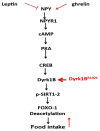New targets to treat obesity and the metabolic syndrome
- PMID: 26001373
- PMCID: PMC4573317
- DOI: 10.1016/j.ejphar.2015.03.093
New targets to treat obesity and the metabolic syndrome
Abstract
Metabolic syndrome (MetS) is a cluster ofassociated metabolic traits that collectively confer unsurpassed risk for development of cardiovascular disease (CVD) and type 2 diabetes compared to any single CVD risk factor. Truncal obesity plays an exceptionally critical role among all metabolic traits of the MetS. Consequently, the prevalence of the MetS has steadily increased with the growing epidemic of obesity. Pharmacotherapy has been available for obesity for more than one decade, but with little success in improving the metabolic profiles. The serotonergic drugs and inhibitors of pancreatic lipases were among the few drugs that were initially approved to treat obesity. At the present time, only the pancreatic lipase inhibitor orlistat is approved for long-term treatment of obesity. New classes of anti-diabetic drugs, including glucagon-like peptide 1 receptor (GLP-1R) agonists and Dipeptidyl-peptidase IV (DPP-IV) inhibitors, are currently being evaluated for their effects on obesity and metabolic traits. The genetic studies of obesity and metabolic syndrome have identified novel molecules acting on the hunger and satiety peptidergic signaling of the gut-hypothalamus axis or the melanocortin system of the brain and are promising targets for future drug development. The goal is to develop drugs that not only treat obesity, but also favorably impact its associated traits.
Keywords: Diabetes; Drugs; Humans; Metabolic syndrome; Obesity; Targets; Therapeutics.
Copyright © 2015 Elsevier B.V. All rights reserved.
Figures



Similar articles
-
[Pharmacological therapy of obesity].G Ital Cardiol (Rome). 2008 Apr;9(4 Suppl 1):83S-93S. G Ital Cardiol (Rome). 2008. PMID: 18773755 Italian.
-
The metabolic syndrome: a critical appraisal based on the CUORE epidemiologic study.Prev Med. 2009 Jun;48(6):525-31. doi: 10.1016/j.ypmed.2009.03.017. Epub 2009 Apr 1. Prev Med. 2009. PMID: 19344739
-
Emerging aspects of pharmacotherapy for obesity and metabolic syndrome.Pharmacol Res. 2004 Nov;50(5):453-69. doi: 10.1016/j.phrs.2004.02.004. Pharmacol Res. 2004. PMID: 15458765 Review.
-
Different obesity phenotypes, and incident cardiovascular disease and mortality events in elderly Iranians: Tehran lipid and glucose study.Geriatr Gerontol Int. 2015 Apr;15(4):449-56. doi: 10.1111/ggi.12295. Epub 2014 Apr 21. Geriatr Gerontol Int. 2015. PMID: 24750352
-
The dark side of testosterone deficiency: I. Metabolic syndrome and erectile dysfunction.J Androl. 2009 Jan-Feb;30(1):10-22. doi: 10.2164/jandrol.108.005215. Epub 2008 Jul 17. J Androl. 2009. PMID: 18641413 Review.
Cited by
-
Pharmacokinetics of Myo-Inositol in a Wistar Rat Animal Model.Int J Mol Sci. 2022 Sep 24;23(19):11246. doi: 10.3390/ijms231911246. Int J Mol Sci. 2022. PMID: 36232547 Free PMC article.
-
miR-26 suppresses adipocyte progenitor differentiation and fat production by targeting Fbxl19.Genes Dev. 2019 Oct 1;33(19-20):1367-1380. doi: 10.1101/gad.328955.119. Epub 2019 Sep 5. Genes Dev. 2019. PMID: 31488578 Free PMC article.
-
Health-Promoting Properties of Selected Cyclitols for Metabolic Syndrome and Diabetes.Nutrients. 2019 Sep 30;11(10):2314. doi: 10.3390/nu11102314. Nutrients. 2019. PMID: 31574903 Free PMC article. Review.
-
Links Between Obesity-Induced Brain Insulin Resistance, Brain Mitochondrial Dysfunction, and Dementia.Front Endocrinol (Lausanne). 2018 Aug 31;9:496. doi: 10.3389/fendo.2018.00496. eCollection 2018. Front Endocrinol (Lausanne). 2018. PMID: 30233495 Free PMC article. Review.
-
Potential Anti-obesogenic Effects of Ginkgo biloba Observed in Epididymal White Adipose Tissue of Obese Rats.Front Endocrinol (Lausanne). 2019 May 10;10:284. doi: 10.3389/fendo.2019.00284. eCollection 2019. Front Endocrinol (Lausanne). 2019. PMID: 31133986 Free PMC article.
References
-
- Abate N. Obesity and cardiovascular disease. Pathogenetic role of the metabolic syndrome and therapeutic implications. J Diabetes Complications. 2000;14:154–174. - PubMed
-
- Adrian TE, Ferri GL, Bacarese-Hamilton AJ, Fuessl HS, Polak JM, Bloom SR. Human distribution and release of a putative new gut hormone, peptide YY. Gastroenterology. 1985;89:1070–1077. - PubMed
-
- Al-Quobaili F, Montenarh M. Pancreatic duodenal homeobox factor-1 and diabetes mellitus type 2 (review) Int J Mol Med. 2008;21:399–404. - PubMed
-
- Albrink MJ, Meigs JW. The relationship between serum triglycerides and skinfold thickness in obese subjects. Ann N Y Acad Sci. 1965;131:673–683. - PubMed
-
- Alpert MA, Hashimi MW. Obesity and the heart. Am J Med Sci. 1993;306:117–123. - PubMed
Publication types
MeSH terms
Grants and funding
LinkOut - more resources
Full Text Sources
Other Literature Sources
Medical

